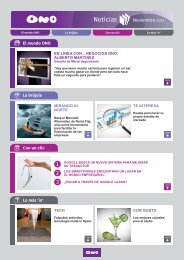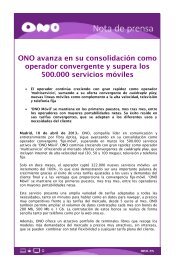Annual Report 2012 - Ono
Annual Report 2012 - Ono
Annual Report 2012 - Ono
Create successful ePaper yourself
Turn your PDF publications into a flip-book with our unique Google optimized e-Paper software.
What does ONO do?<br />
ONO’s network<br />
Transmission Network<br />
The Transmission Network is responsible<br />
for connecting ONO’s multiple nodes and<br />
service centres across Spain. The network<br />
is composed of a very large amount of<br />
transmission equipment that is connected<br />
with each other by various technologies<br />
(mainly fibre, complemented by radio).<br />
The equipment of the Transmission<br />
Network uses various standards (SDH,<br />
WDM, Ethernet) which are designed to<br />
transmit large volumes of information for<br />
long distances (hundreds or thousands of<br />
Km). The Transmission Network transports<br />
traffic of any kind – data, voice, or<br />
audiovisual services – in a transparent way<br />
to comply with the quality requirements<br />
for each kind of traffic (error rate, margins<br />
for round trip delay times and jitter, % of<br />
service availability, etc.). The architecture<br />
of the Transmission Network is generally<br />
adapted to the geography of the service<br />
nodes whose traffic it carries. The nodes<br />
tend to be organised into various basic<br />
sub-networks that use different forms<br />
(ring, point to point, bus, point to multipoint,<br />
mesh). Ring or mesh networks are<br />
able to create redundancy using specific<br />
mechanisms, so that multiple paths are<br />
available to transport the traffic in the<br />
event of failures.<br />
The Transmission Network is also<br />
segmented by geographic level. Depending<br />
on the location of the nodes and<br />
connections, the network is categorised<br />
into Backbone, Regional and Metropolitan.<br />
- The Trunk Network is formed of high<br />
capacity long distance links that connect<br />
the main nodes, mainly located in large<br />
cities. These links connect the main<br />
nodes and aggregate traffic from their<br />
geographies to exchange this traffic with<br />
other regions and/or metropolitan areas,<br />
at transmissions rates of up to Tb/s. The<br />
Backbone Network of ONO can provide<br />
connections of up to 10 Gbps and new<br />
capacities of 40 Gbps and 100 Gbps are<br />
planned for the coming years, as well as<br />
the possibility of restoration at the optical<br />
level from 2013.<br />
The following is a map of the Trunk and<br />
Regional connections of the <strong>Ono</strong> network<br />
across Spain<br />
ONO in <strong>2012</strong><br />
Who is ONO?<br />
What does ONO do?<br />
Products and services<br />
ONO’s network<br />
Investment<br />
Innovation<br />
ONO’s<br />
Responsibility<br />
Financial analysis<br />
Corporate<br />
Governance <strong>Report</strong><br />
The Figures<br />
Annexes<br />
Contact<br />
Information<br />
Print<br />
<strong>Report</strong><br />
The Figures<br />
43
















